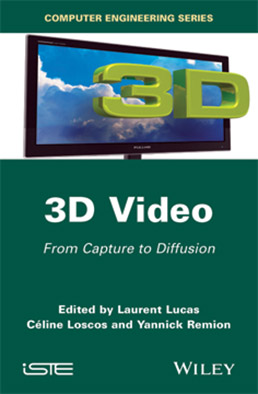
While 3D vision has existed for many years, the use of 3D cameras and video-based modeling by the film industry has induced an explosion of interest for 3D acquisition technology, 3D content and 3D displays. As such, 3D video has become one of the new technology trends of this century.
The chapters in this book cover a large spectrum of areas connected to 3D video, which are presented both theoretically and technologically, while taking into account both physiological and perceptual aspects. Stepping away from traditional 3D vision, the authors, all currently involved in these areas, provide the necessary elements for understanding the underlying computer-based science of these technologies. They consider applications and perspectives previously unexplored due to technological limitations.
This book guides the reader through the production process of 3D videos; from acquisition, through data treatment and representation, to 3D diffusion. Several types of camera systems are considered (multiscopic or multiview) which lead to different acquisition, modeling and storage-rendering solutions. The application of these systems is also discussed to illustrate varying performance benefits, making this book suitable for students, academics, and also those involved in the film industry.
Part 1. 3D Acquisition of Scenes
1. Foundation, Laurent Lucas, Yannick Remion and Céline Loscos.
2. Digital Cameras: Definitions and Principles, Min H. Kim, Nicolas Hautière and Céline Loscos.
3. Multiview Acquisition Systems, Frédéric Devernay, Yves Pupulin and Yannick Remion.
4. Shooting and Viewing Geometries in 3DTV, Jessica Prévoteau, Laurent Lucas and Yannick Remion.
5. Camera Calibration: Geometric and Colorimetric Correction, Vincent Nozick and Jean-Baptiste Thomas.
Part 2. Description/Reconstruction of 3D Scenes
6. Feature Points Detection and Image Matching, Michel Desvignes, Lara Younes and Barbara Romaniuk.
7. Multi- and Stereoscopic Matching, Depth and Disparity, Stéphanie Prévost, Cédric Niquin, Sylvie Chambon and Guillaume Gales.
8. 3D Scene Reconstruction and Structuring, Ludovic Blache, Muhannad Ismael and Philippe Souchet.
9. Synthesizing Intermediary Viewpoints, Luce Morin, Olivier Le Meur, Christine Guillemot, Vincent Jantet and Josselin Gautier.
Part 3. Standards and Compression of 3D Video
10. Multiview Video Coding (MVC), Benjamin Battin, Philippe Vautrot, Marco Cagnazzo and Frédéric Dufaux.
11. 3D Mesh Compression, Florent Dupont, Guillaume Lavoué and Marc Antonini.
12. Coding Methods for Depth Videos, Elie Gabriel Mora, Joël Jung, Béatrice Pesquet-Popescu and Marco Cagnazzo.
13. Stereoscopic Watermarking, Mihai Mitrea, Afef Chammem and Françoise Prêteux.
Part 4. Rendering and 3D Display
14. HD 3DTV and Autostereoscopy, Venceslas Biri and Laurent Lucas.
15. Augmented and/or Mixed Reality, Gilles Simon and Marie-Odile Berger.
16. Visual Comfort and Fatigue in Stereoscopy, Matthieu Urvoy, Marcus Barkowsky, Jing Li and Patrick Le Callet.
17. 2D–3D Conversion, David Grogna, Antoine Lejeune and Benoît Michel.
Part 5. Implementation and Outlets
18. 3D Model Retrieval, Jean-Philippe Vandeborre, Hedi Tabia and Mohamed Daoudi.
19. 3D HDR Images and Videos: Acquisition and Restitution, Jennifer Bonnard, Gilles Valette, Céline Loscos and Jean-Michel Nourrit.
20. 3D Visualization for Life Sciences, Aassif Benassarou, Sylvia Piotin, Manuel Dauchez and Dimitri Papathanassiou.
21. 3D Reconstruction of Sport Scenes, Sébastien Mavromatis and Jean Sequeira.
22. Experiments in Live Capture and Transmission of Stereoscopic 3D Video Images, David Grogna and Jacques G.Verly.
Laurent Lucas currently leads the SIC research group and is in charge of the virtual reality platform of the URCA (University of Reims Champagne Ardenne) in France. His research interests include visualization and co-operation between image processing and computer graphics, particularly in 3DTV, and their applications.
Céline Loscos is Professor at the URCA, within the CReSTIC laboratory, and teaches computer science at the University Institute of Technology (IUT) in Champagne Ardenne, France.
Yannick Remion’s research interests include dynamic animation, simulation and co-operation between image processing and computer graphics as well as 3D vision.